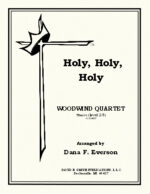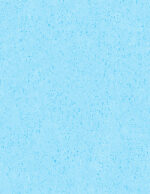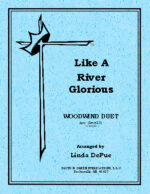-
Holy, Holy, Holy
$9.00Written for flute, oboe, clarinet or saxophone this pieces creates a solemn presence by the way it interweaves the various parts together. It would work well for a meditation.
-
Be Thou My Vision
$9.00A woodwind quartett scored for flutes, clarinets, and other woodwind instruments, this piece presents itself in a gentle, thought provoking manner. The middle section is faster, giving a heightened sense of thought worthiness.
-
Tis So Sweet To Trust
$8.00A quartet for 2 flutes and 2 clarinets with opt. parts for oboe, B. clar., bassoon and Alto sax. After a brief introduction the flutes carry the melodic material and then shifting the chorus to the clarinets. A modulation shifts the attention to the clarinet melody with punctuation remarks in the other instruments. Further transition moves to another modulation where thematic motifs are passed around in a fughetta fashion where it then becomes more choral in nature ending in a solemn statement.
-
Praise Him! Praise Him
$8.00A woodwind trio for flute. Flute/oboe and clarinet; unaccompanied. Like a stately march the introduction uses a motif gravitating through several harmonic changes giving way to a modified thematic presentation with all three parts being in active counterpoint.and the tune passed about all the parts. The tune then moves about in a hocket fashion keeping all parts busy. The final section is somewhat in keeping with the first section coming to a solid “Praise Him” conclusion.
-
-
O To Be Like Thee
$8.00A woodwind trio for flutes and clarinet with opt. part for oboe, clarinet and alto sax. In a triple meter the piece begins in a lilting fashion. A lot of interesting counterpoint keeps the piece flowing with constant movement. A modulation occurs and the rythmic activity increases while the countrapuntal activity continues. Another modulation takes place and shifts to a duple meter while the melodic material is passed around amongst the various parts. The final section goes back to a triple meter and uses the flavor of the beginning.
-
God Leads His Dear Children Along
$9.00This woodwind trio consists of combinations for flute, oboe, clarinet or saxophone in a cheerful manner. It gives the feeling of the joy of being one of God’s children and can be used for many different, special occasions.
-
A Passion For Thee
$8.00This woodwind trio begins with a delightful moving motive in the piano to be joined with the first part, then a duet with part two and then a trio with all three parts. The next section is solemn as the piano drops out and then all join in for an active presentation. The last section begins the theme in the third part with some imitation from part two until the first part takes over the theme and continues in this manner. The coda is simple giving a sense of peace.
-
-
To God Be The Glory
$6.00This duet with piano uses some expressive, interactive cadenza work between the duet parts in the beginning and during the work. It is vigorous in nature otherwise and ends with a torrent of joy!
-
Like A River Glorious
$7.00This woodwind duet would be useful as a special presentation in a service. The nature of the work portrays great joy, variety, and dimension. The conclusive sections are deliberate and strong.
-
-
What A Friend
$5.00A duet for clarinet and saxophone that begins with a brief introduction in the piano. The clarinet then presents the tune in a straight-forward rendition with the saxophone supporting with a moving harmonization ending with a melodic line. The second section presents the tune in the saxophone while the clarinet overlays with a gentle obligato. The third section goes back to the structure of the beginning briefly and then shifts back to the obligato addition and then settles into a final repose.
-
What A Friend
$5.00A duet for flute and clarinet that begins with a brief introduction in the piano. The flute then presents the tune in a straight-forward rendition with the clarinet supporting with a moving harmonization ending with a melodic line. The second section presents the tune in the claeint while the flute overlays with a gentle obligato. The third section goes back to the structure of the beginning briefly and then shifts back to the obligato addition and then settles into a final repose.
-
And Can It Be
$9.00Scored for full saxophone quartet, this piece immediately marches off with the dignity that this grand old hymn portrays. The theme is passed around amongst the various parts to add player satisfaction and joy to the listener. (S/A-A-T-B)
-
What A Friend
$9.00Scored for Saxophone quartet (A-A-T-B) with opt. Soprano for first Alto. The introduction starts with the First Alto playing a melodic motif, ever rising to a climatic point and then settling down to the theme- first presented in the First and Tenor parts weaving in and out producing a flowing texture, then joined by the Second Alto and eventually the Baritone. The chorus section of the hymn is a constant weaving of the four parts both harmonically and rhythmically. The next section becomes more active rhythmically adding tension until it settles down into a sweet aura of sound with gentle nudges of harmonic alteration. The final measures give an atmosphere of rest and solace.
-
Blessed Be The Name
$9.00This saxophone quartet is portrayed in a crisp and cheerful manner. The theme is passed around among the various parts and gains excitement as it passes through several keys. Surely a delight as a special number in any venue. (S/A-A-T-B)
-
-
Holy, Holy, Holy
$7.00Written for Saxophone quartet, this pieces creates a solemn presence by the way it interweaves the various parts together. It would work well for a meditation.
-
Power in the Blood
$8.00This saxophone trio with piano accompaniment is presented in a solid, determined manner. It makes a definitive statement in the “Power in the Blood” of Christ. The middle section changes meter while maintaining the character of the opening.
-
The Bible Stands
$9.00An unaccompanied saxophone trio (A-A-A/T) begins from the “git-go” with the melody in the first part with parts two and three adding harmonic and rhythmic interest. A brief modulation and interlude leads into the next section after another modulation with the parts interplaying amongst themselves. Yet, another modulation with block harmonies giving over to yet another modulation and a final ending!
-
Count Your Blessings
$9.00“Count Your Blessings” is a hymn of not only thanksgiving but continual expression throughout the year. This trio is essentially triadic in the opening section and then moves with more embellishment and excitement.
-
As The Deer
$8.50This saxophone arrangement of As The Deer is a gentle interplay of parts and gives the sensation of a constant flowing steam of water that offers a background for quiet reflection. Tenor sax opt for Alto 3.

























